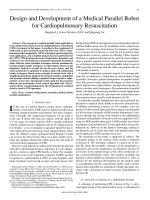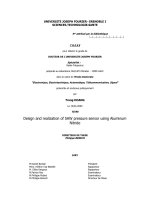Design and development of tissue engineering scafflods using rapid prototyping technology
Bạn đang xem bản rút gọn của tài liệu. Xem và tải ngay bản đầy đủ của tài liệu tại đây (53.57 KB, 9 trang )
Chapter One: Introduction
Chapter One
Introduction
1
Chapter One: Introduction
1.1 Background
At present, many strategies for tissue engineering (TE) require scaffolds that,
by acting as a surrogate extracellular matrix, provide an initial site for cells to
anchor, grow and proliferate. Furthermore, a biodegradable scaffold that could
be implanted into a defect site, promote regeneration of tissue, and then
degrade over time as new tissue reclaims the site (Han et al, 1998). Such
scaffolds can be cultured with cells prior to implantation (cellular strategy) or
alternatively implanted without cells (guided tissue regeneration strategy)
(Patrick et al, 1998). These strategies have been studied for the regeneration
of many tissues, including bone and cartilage (Perka et al, 2000; Whang et al,
1998). A number of materials as well as scaffold design have been
experimentally and/or clinically studied. For the treatment of tissues/organs in
malfunction, one of the challenges in the field of tissue engineering is the
design of various types of scaffolds that can mimic the structure and biological
functions of the natural extracellular matrices (ECM) of different tissues.
The minimum requirements for TE scaffolds are as follows (Hutmacher,
2001a):
a) Three-dimensional and highly porous with an interconnected pore
network to favour flow transport of nutrients and metabolic waste, and
tissue integration and vascularization
b) Biodegradable or bioresorbable with a controllable degradation and
resorption rate to match cell/tissue growth in vitro and/or in vivo
c) Suitable surface chemistry for cell attachment, proliferation, and
differentiation
2
Chapter One: Introduction
d) Favourable mechanical properties to match those of the tissues at the
site of implantation
e) Be easily fabricated to form a variety of shapes and sizes
In the early days of tissue engineering, FDA approved devices and implants
made of polymers of synthetic origin, such as sutures, meshes etc. were used
(Chaignaud et al, 1997). Later, techniques were developed to fabricate
polymeric scaffolds based on either heating macromolecules or dissolving
them in a suitable organic solvent. In these techniques, the viscous behaviour
of the polymers above their melting temperatures, and their solubility in
various organic solvents are the important characteristics, which determine
the type of process that will be used. Based on the use of organic solvents, a
number of techniques have been developed to design and fabricate porous
3D bioresorbable scaffolds for tissue engineering applications (Lu et al, 1996).
These scaffold-processing techniques, called conventional/traditional
techniques include solvent casting and particulate leaching, gas foaming, fibre
meshes/fibre bonding, temperature-induced phase separation (TIPS), melt
moulding, emulsion freeze drying, solution casting, membrane lamination and
freeze drying (Sachlos and Czernuszka, 2003). A wide range of scaffold
characteristics such as pore morphology, pore size and porosity, has been
reported using such conventional fabrication techniques (Widmer and Mikos,
1998). However, these techniques often remain impractical because they
cannot provide control over scaffold design (e.g. complex & reproducible
architectures and compositional variation across the entire structure) to
achieve specified properties within required limits on morphological
3
Chapter One: Introduction
characteristics (Lin et al, 2004). To overcome this hurdle, rapid prototyping
(RP), called solid free form (SFF) fabrication techniques have been introduced
with high encouragement for scaffold fabrication.
RP is a fast growing popular technology that enables quick and easy
fabrication of customised forms directly from computer aided design (CAD)
model to solid model. The needs for quick product development, decreased
time to market, and highly customised and low quantity parts are driving the
demand for RP technology (Kochan, 1997). The flexible manufacturing
capabilities of RP techniques have been applied to biomedical engineering
applications ranging from the production of scale replicas of human bones
(D’Urso et al, 2000) and body organs (Sanghera et al, 2001) to advanced
customized drug delivery devices (Leong et al, 2001) and other areas of
medical sciences including anthropology (Recheis et al, 1999), palaeontology
(Zollikofer and De Leon, 1995) and medical forensics (Vanezi et al, 2000).
Today, RP technique is regarded as an efficient tool to reproducibly generate
scaffolds with tailored properties on a large scale (Sacholos and Czernuszka,
2003; Hollister et al, 2000). The widely studied RP techniques include
stereolithography apparatus (SLA), selective laser sintering (SLS), three-
dimensional printing (3DP), fused deposition modeling (FDM), 3D plotting,
multiphase jet solidification (MJS), 3D fiber deposition and precise extrusion
manufacturing (PEM) (Wu et al, 1996; Koch et al, 1998; Zein et al, 2002,
Woodfield et al, 2004; Wang et al, 2004; Williams et al, 2005). These
techniques will be elaborated in the next chapter (literature review).
4
Chapter One: Introduction
1.2 Hypothesis
The variation in macro/micro architecture and material would modulate the
morphological and biomechanical characteristics of the scaffold. Therefore,
the rapid prototyping (RP) technology in combination with novel synthetic
polymer(s) would allow developing a scaffold family that could cater broad
tissue engineering applications.
1.3 Significance of Hypothesis
Tissue engineering leads to new medical therapies for injury and organ
disease through use of living cells together with polymeric biomaterials. Cells
live in a nano- and/or micro-featured environment with natural extracellular
matrix comprised of a complex mixture of pores, ridges, fibres and networks.
Fundamental understanding of interactions between cells and their living
environments, such as extracellular matrix, is critical for design and
development of efficient tissue engineering devices. In this regard, the
biochemical and topographic cues of the scaffolds play significant roles in the
cell behaviours, such as cell adhesion, proliferation, migration and
differentiation. On top of that, the mechanical strength of the bioresorbable
scaffold should match that of the host tissue at the time of implantation as
closely as possible, and should retain until the tissue engineered transplant is
fully constructed that can assume its structural role (Hutmacher, 2000).
Therefore, in the development of a tissue engineering scaffold, there remains
a great challenge to mimic the structural and biological functions of natural
ECM. The novel polymer aims to modulate the hydrophilicity, biodegradability
and mechanical properties as required for targeted tissue. Besides, the RP
5
Chapter One: Introduction
technique would allow generation of 3D scaffolds with fully interconnected and
highly reproducible pore networks similar to honeycomb-like pattern that will
accomplish morphological and biomechanical requirements for tailored tissue
engineered applications.
1.4 Research Aims
The overall objective of this PhD research is to develop and characterize a 3D
scaffold family with a range of morphological and biomechanical properties by
the combination of synthetic polymer(s) and in house built rapid prototyping
(RP) technique.
To achieve the above-mentioned objective, this research aims at the
following:
¾ In house design and development of a melt extrusion based system,
called desktop robot based rapid prototyping (DRBRP) technique to
process synthetic biopolymers into 3D scaffolds
¾ Design and fabrication of 3D scaffold family with various architectures
utilizing a range of biopolymers
¾ Physical (morphological and mechanical) characterization of the
scaffolds
¾ Evaluation of degradation behavior and kinetics of the scaffolds
¾ Cell culture study that would investigate the cell compatibility and
neotissue formation onto the scaffolds
6
Chapter One: Introduction
1.5 Structure of Thesis
The overall research program can be carried out in five phases.
Phase I focuses on development of the DRBRP technique to process
synthetic biopolymers into 3D scaffolds of honeycomb-like architecture with
various pore shape, size and porosity while maintaining complete
interconnectivity and reproducibility throughout the structure. The DRBRP
technique allows direct extrusion of the material from its granulated or any
other form into 3D scaffold in contrast to traditional FDM system that requires
preparation of filament or any other pre-cursor. This work involves design and
manufacturing of the necessary hardware namely, liquefier or melting
chamber, insulating jacket for the chamber, extrusion nozzle etc. and further
incorporation with the commercial “Sony Robot” operated by RPBOD
software. Virtually, DRBRP system allows to process any thermoplastic
material into 3D scaffold with any lay-down pattern.
Phase II initially investigates the efficacy of the DRBRP technique to process
a wide range of biopolymers namely, PCL and PCL-based copolymers (PCL-
PEG, PCL-PEG-PCL and PEG-PCL-PLA). In the beginning, four polymers
prepared by ring-opening polymerization were experimented to investigate the
feasibility of these polymers to be processed into 3D scaffold by the DRBRP
technique. These materials were taken into consideration because they had
the potential to modulate hydrophilicity and/or degradability and consequently,
the biomechanical properties of the matrices for tailored tissue engineered
7
Chapter One: Introduction
applications by varying the ratio of the polymer components. Afterward, this
work focuses on using two polymers (PCL and PCL-PEG) throughout the
project assuming that it would produce ample data to justify the objective of
this research and ultimately, to avoid overwhelming of data. The fabrication
process was optimized by varying the process parameters (liquefier
temperature, extrusion pressure and deposition speed). Finally, a family of
scaffolds was fabricated with various lay-down patterns and filament
distances applying the optimized process parameters.
Phase III performs the physical characterization of the developed scaffolds
that evaluates the morphological and mechanical properties. The
morphological characterization investigates the influence of process
parameters, lay-down patterns and filament distances on the pore size, shape
and porosity of the scaffolds. Likewise, the mechanical characterization
studies the influence of process parameters, lay-down patterns and filament
distances on the mechanical properties of the scaffolds. The mechanical
characterization also reveals the effect of strain rate, simulated physiological
environment and loading direction on the scaffolds’ mechanical properties.
Phase IV evaluates the degradation behavior and kinetics of the scaffolds.
This study investigates mainly, the effect of the variation in material and lay-
down pattern on the degradation kinetics of the scaffolds in terms of mass
loss, and change in morphological and mechanical properties.
8
Chapter One: Introduction
Phase V focuses on the in vitro cell culture study that investigates the cell
compatibility and neotissue formation onto the scaffolds. Scaffold surface and
morphology to which the cells adhere, affect bio- and electrochemical signals
that control cell migration, proliferation and differentiation. The qualitative and
quantitative analyses of cell adhesion and proliferation to the scaffold surface
and architecture are the basic fundamentals of studying biocompatibility of
new scaffold in tissue engineering research. In the preliminary study, human
fibroblasts are used to assess the general biocompatibility of PEG-PCL-PLA
scaffolds. Further, rabbit smooth muscle cells are cultured to evaluate
biocompatibility and cellular functions onto the PCL and PCL-PEG scaffolds.
This study investigates the variation in cell adhesion and function due to the
variation of material and scaffold architecture. Light, scanning electron, and
confocal laser microscopy are used to assess qualitatively cell adhesion,
proliferation and extracellular matrix production while, the PicoGreen DNA
allows to study cell proliferation from a quantitative point of view.
9









